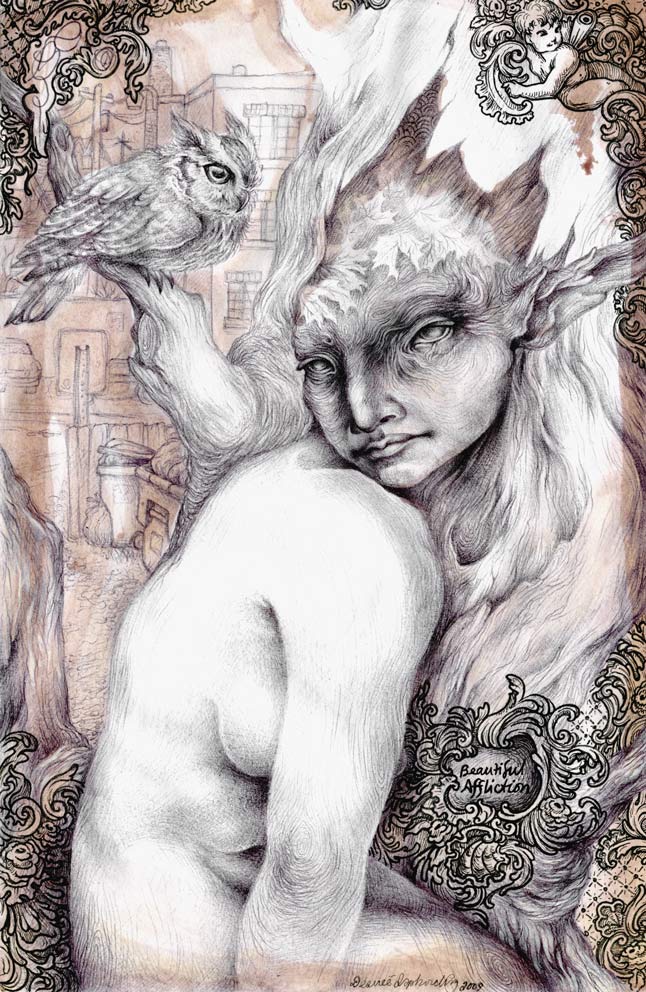By the parking area behind my apartment building there is a particular maple tree who has captured my interest. Her figure is not tall and lean as those of her nearby siblings; she is hunched, warped, and turns upon herself at peculiar angles, and yet in my opinion possesses an elegance that her sisters do not. In the frigid days following my own sister's wedding, a bouquet of white carnations lay in my passenger's seat preserved by the cold. It seemed such a waste to throw them away (what good would come of them trapped in black plastic, preventing them from joining the soil?) so I made a gift of them. Hands gnarled like her branches and numbing in the chill night air, I pulled each flower from its crowded foam base and arranged them in one of the maple's holes near the where her roots wind their way into the ground. I smiled and wordlessly thanked her for her company. It was not too long afterwords that this drawing began, and as the unusual features and awkward torsion emerged I recognized the maple tree who greets me everyday when I leave for work and return in the evenings.
A burl is a term used to refer to an abnormal, fast-growing, bulbous arboreal growth — something almost akin to a tumor. They are typically caused by some sort of stress either resulting from fungus, insects, or sometimes by human involvement and disruption. Burls can often grow to be quite large and many times trees die from their burden. Yet what otherwise might be regarded as misshapen and diseased is highly sought by woodworkers, for beneath the crumpled bark covering the burl like a scab is wood whose grain is intricately whorled and nearly liquid with motion. Certain varieties of burl wood can command high prices. It adorns items of expense and opulence, and can often be found in the interiors of luxury cars and as veneers on fine furniture. This contrast of appreciation for its outer and interior forms is represented by the ornate Roccoco border. In a strange reversal of how our society typically operates, it actually is what's inside that counts and the outer form is not usually so well-regarded.
It is also a statement about how we might wish Otherworldy creatures to perpetually appear versus how they tend to truly reveal Themselves. Contrary to today's vision of Faerie as represented by the cherubic winged sprite in the upper right corner, faeries were often strange and grotesque — and yet their homely visage did not preclude them from being respected and revered:
The representations of fairy and demon familiars found in early modern encounter-narratives reflect the animist culture of the rural village, as opposed to the theistic culture of the cloister or oak-panelled study. [...] [A]mong the common folk of this period, the assortment of spirits which came under the umbrella term of fairies — bizarre and sometimes ridiculous-looking as they were — possessed the numen of sacred beings, and as such were objects for devotion. [...] This devotion was not only reserved for the beautiful and/or noble fairy monarchy and other spirits who conformed in some way to stereotypical Christian notions about sacred beings [...].1
I thought it was very important to anchor this piece in the real world where this tree actually grows. The background is very closely based to the actual location where this Maple spreads her branches. She would not hold the same poignancy were I to draw her in some enchanted glade where a glittering unicorn might nibble her leaves as that is not where she belongs. If we cannot find beauty where we are, there is little hope of truly finding it elsewhere.
Media: black ballpoint pen, ink, acrylic, pen & ink
Size: 5.5 x 8.5 inches

Footnotes and Bibliography
1) Wilby, Emma. Cunning Folk and Familiar Spirits. ISBN 1-84519-078-5. 226.




No comments:
Post a Comment